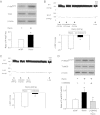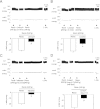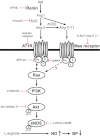Renin activates PI3K-Akt-eNOS signalling through the angiotensin AT₁ and Mas receptors to modulate central blood pressure control in the nucleus tractus solitarii
- PMID: 22224457
- PMCID: PMC3402768
- DOI: 10.1111/j.1476-5381.2012.01832.x
Renin activates PI3K-Akt-eNOS signalling through the angiotensin AT₁ and Mas receptors to modulate central blood pressure control in the nucleus tractus solitarii
Abstract
Background and purpose: The renin-angiotensin system (RAS) is critical for the control of blood pressure by the CNS. Recently, direct renin inhibitors were approved as antihypertensive agents. However, the signalling mechanism of renin, which regulates blood pressure in the nucleus tractus solitarii (NTS) remains unclear. Here we have investigated the signalling pathways involved in renin-mediated blood pressure regulation, at the NTS.
Experimental approach: Depressor responses to renin microinjected into the NTS of Wistar-Kyoto rats were elicited in the absence and presence of the endothelial nitric oxide synthase (eNOS)-specific inhibitor, N(5)-(-iminoethyl)-L-ornithine, Akt inhibitor IV and LY294002, a PI3K inhibitor and GP antagonist-2A [G(q) inhibitor]. Lisinopril (angiotensin converting enzyme inhibitor), losartan, valsartan (angiotensin AT(1) receptor antagonists), D-Ala7-Ang-(1-7) (angiotensin-(1-7) receptor antagonist) were used to study the involvement of RAS on renin-induced depressor effects.
Key results: Microinjection of renin into the NTS produced a prominent depressor effect and increased NO production. Pretreatment with G(q) -PI3K-Akt-eNOS pathway-specific inhibitors significantly attenuated the depressor response evoked by renin. Immunoblotting and immunohistochemical studies further showed that inhibition of PI3K significantly blocked renin-induced eNOS-Ser ¹¹⁷ and Akt-Ser⁴⁷³ phosphorylation in situ. In addition, pre-treatment of the NTS with RAS inhibitors attenuated the vasodepressor effects evoked by renin. Microinjection of renin also increased Ras activation in the NTS.
Conclusions and implications: Taken together, these results suggest renin modulated blood pressure at the NTS by AT₁ and Mas receptor-mediated activation of G(q) and Ras to evoke PI3K-Akt-eNOS signalling.
© 2012 The Authors. British Journal of Pharmacology © 2012 The British Pharmacological Society.
Figures






Similar articles
-
Involvement of Endothelial Nitric Oxide Synthase Activation in Midkine-Mediated Central Hypotensive Effects.Chin J Physiol. 2017 Dec 31;60(6):353-362. doi: 10.4077/CJP.2017.BAG512. Chin J Physiol. 2017. PMID: 29241309
-
Simvastatin induces a central hypotensive effect via Ras-mediated signalling to cause eNOS up-regulation.Br J Pharmacol. 2013 Oct;170(4):847-58. doi: 10.1111/bph.12317. Br J Pharmacol. 2013. PMID: 23889671 Free PMC article.
-
The PI3K signaling-mediated nitric oxide contributes to cardiovascular effects of angiotensin-(1-7) in the nucleus tractus solitarii of rats.Nitric Oxide. 2016 Jan 30;52:56-65. doi: 10.1016/j.niox.2015.12.002. Epub 2015 Dec 12. Nitric Oxide. 2016. PMID: 26686278
-
Vascular-brain signaling in hypertension: role of angiotensin II and nitric oxide.Curr Hypertens Rep. 2007 Jun;9(3):242-7. doi: 10.1007/s11906-007-0043-1. Curr Hypertens Rep. 2007. PMID: 17519132 Review.
-
Signalling across the blood brain barrier by angiotensin II: novel implications for neurogenic hypertension.J Mol Med (Berl). 2008 Jun;86(6):705-10. doi: 10.1007/s00109-008-0324-4. Epub 2008 Apr 29. J Mol Med (Berl). 2008. PMID: 18443753 Review.
Cited by
-
Regression of a venous malformation during angiotensin-converting enzyme inhibitor treatment for hypertension.J Vasc Surg Cases Innov Tech. 2022 Sep 17;8(4):657-659. doi: 10.1016/j.jvscit.2022.09.004. eCollection 2022 Dec. J Vasc Surg Cases Innov Tech. 2022. PMID: 36262918 Free PMC article.
-
Affinity Purification and Molecular Characterization of Angiotensin-Converting Enzyme (ACE)-Inhibitory Peptides from Takifugu flavidus.Mar Drugs. 2023 Sep 29;21(10):522. doi: 10.3390/md21100522. Mar Drugs. 2023. PMID: 37888457 Free PMC article.
-
GPCR dimerization in brainstem nuclei contributes to the development of hypertension.Br J Pharmacol. 2015 May;172(10):2507-18. doi: 10.1111/bph.13074. Epub 2015 Mar 17. Br J Pharmacol. 2015. PMID: 25573074 Free PMC article.
-
Gabapentin Reduces Blood Pressure and Heart Rate through the Nucleus Tractus Solitarii.Acta Cardiol Sin. 2019 Nov;35(6):627-633. doi: 10.6515/ACS.201911_35(6).20190429B. Acta Cardiol Sin. 2019. PMID: 31879515 Free PMC article.
-
miRNA-145 is associated with spontaneous hypertension by targeting SLC7A1.Exp Ther Med. 2018 Jan;15(1):548-552. doi: 10.3892/etm.2017.5371. Epub 2017 Oct 24. Exp Ther Med. 2018. PMID: 29434681 Free PMC article.
References
-
- Alzamora AC, Santos RAS, Campagnole-Santos MJ. Hypotensive effect of ANG II and ANG-(1-7) at the caudal ventrolateral medulla involves different mechanisms. Am J Physiol Regul Integr Comp Physiol. 2002;283:R1187–R1195. - PubMed
-
- Averill DB, Tsuchihashi T, Khosla MC, Ferrario CM. Losartan, nonpeptide angiotensin II-type 1 (AT1) receptor antagonist, attenuates pressor and sympathoexcitatory responses evoked by angiotensin II andL-glutamate in rostral ventrolateral medulla. Brain Res. 1994;665:245–252. - PubMed
-
- Brown MJ. Aliskiren. Circulation. 2008;118:773–784. - PubMed
-
- Calabrese V, Mancuso C, Calvani M, Rizzarelli E, Butterfield DA, Stella AM. Nitric oxide in the central nervous system: neuroprotection versus neurotoxicity. Nat Rev Neurosci. 2007;8:766–775. - PubMed
Publication types
MeSH terms
Substances
LinkOut - more resources
Full Text Sources
Research Materials
Miscellaneous

